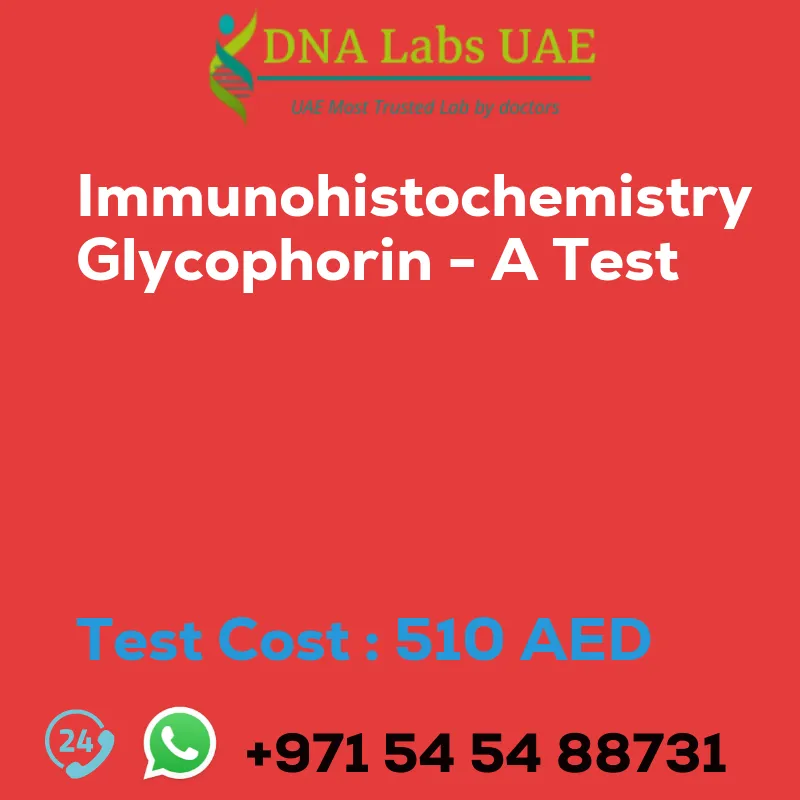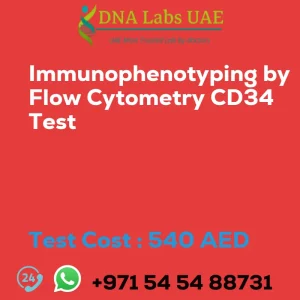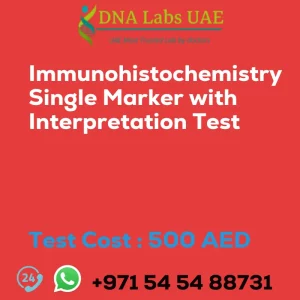IMMUNOHISTOCHEMISTRY GLYCOPHORIN-A Test
Test Name: IMMUNOHISTOCHEMISTRY GLYCOPHORIN-A Test
Components: Glycophorin-A (GPA)
Price: 510.0 AED
Sample Condition: Submit tumor tissue in 10% Formal-saline OR Formalin fixed paraffin embedded block. Ship at room temperature. Provide a copy of the Histopathology report, Site of biopsy and Clinical history.
Report Delivery: Sample Daily by 6 pm; Report Block: 5 days, Tissue Biopsy: 5 days, Tissue large complex: 7 days
Method: Immunohistochemistry
Test Type: Cancer
Doctor: Oncologist, Pathologist
Test Department: HISTOLOGY
Pre Test Information: Provide a copy of the Histopathology report, Site of biopsy and Clinical history.
Test Details
Immunohistochemistry (IHC) is a technique used to detect and localize specific proteins in tissues using antibodies. The IMMUNOHISTOCHEMISTRY GLYCOPHORIN-A Test specifically focuses on Glycophorin-A (GPA), a glycoprotein primarily found on the surface of red blood cells.
The process of immunohistochemistry for glycophorin-A involves several steps:
- Tissue Preparation: Tissue sections are prepared from formalin-fixed, paraffin-embedded blocks or frozen tissues. These sections are mounted on glass slides.
- Antigen Retrieval: Formalin-fixed tissues require antigen retrieval to unmask the protein epitopes. This is done by treating the tissue sections with heat or enzymatic methods.
- Blocking: Non-specific binding sites on the tissue sections are blocked using a protein blocking agent, such as bovine serum albumin or normal serum.
- Primary Antibody Incubation: A primary antibody specific to glycophorin-A is added to the tissue sections and incubated overnight at a specific temperature. The primary antibody binds to the glycophorin-A protein in the tissue.
- Secondary Antibody Incubation: After washing away unbound primary antibody, a secondary antibody is added. The secondary antibody is conjugated with a marker, such as an enzyme (e.g., horseradish peroxidase) or a fluorescent dye.
- Visualization: The marker on the secondary antibody allows for visualization of the bound primary antibody. Enzyme-based markers produce a colored reaction product when a substrate is added, while fluorescent markers emit light of a specific wavelength when excited by a specific light source.
- Counterstaining: To enhance visualization and provide contrast, the tissue sections may be counterstained with a dye, such as hematoxylin or eosin.
- Microscopic Examination: The stained tissue sections are examined under a microscope to evaluate the presence and localization of glycophorin-A in the tissue.
The IMMUNOHISTOCHEMISTRY GLYCOPHORIN-A Test is commonly used in research and diagnostic settings to study erythroid cells, identify hematopoietic tumors, and differentiate between various types of tumors based on their expression of glycophorin-A. It provides valuable information about the distribution and localization of glycophorin-A in different tissues and can aid in the diagnosis and classification of various diseases.
| Test Name | IMMUNOHISTOCHEMISTRY GLYCOPHORIN – A Test |
|---|---|
| Components | |
| Price | 510.0 AED |
| Sample Condition | Submit tumor tissue in 10% Formal-saline OR Formalin fixed paraffin embedded block. Ship at room temperature. Provide a copy of the Histopathology report, Site of biopsy and Clinical history. |
| Report Delivery | Sample Daily by 6 pm; Report Block: 5 days Tissue Biopsy: 5 days Tissue large complex : 7 days |
| Method | Immunohistochemistry |
| Test type | Cancer |
| Doctor | Oncologist, Pathologist |
| Test Department: | HISTOLOGY |
| Pre Test Information | Provide a copy of the Histopathology report, Site of biopsy and Clinical history. |
| Test Details |
Immunohistochemistry (IHC) is a technique used to detect and localize specific proteins in tissues using antibodies. Glycophorin-A (GPA) is a glycoprotein that is primarily found on the surface of red blood cells. The GPA test in immunohistochemistry helps in identifying and studying erythroid cells and their differentiation in various tissues. The process of immunohistochemistry for glycophorin-A involves several steps: 1. Tissue Preparation: Tissue sections are prepared from formalin-fixed, paraffin-embedded blocks or frozen tissues. These sections are mounted on glass slides. 2. Antigen Retrieval: Formalin-fixed tissues require antigen retrieval to unmask the protein epitopes. This is done by treating the tissue sections with heat or enzymatic methods. 3. Blocking: Non-specific binding sites on the tissue sections are blocked using a protein blocking agent, such as bovine serum albumin or normal serum. 4. Primary Antibody Incubation: A primary antibody specific to glycophorin-A is added to the tissue sections and incubated overnight at a specific temperature. The primary antibody binds to the glycophorin-A protein in the tissue. 5. Secondary Antibody Incubation: After washing away unbound primary antibody, a secondary antibody is added. The secondary antibody is conjugated with a marker, such as an enzyme (e.g., horseradish peroxidase) or a fluorescent dye. 6. Visualization: The marker on the secondary antibody allows for visualization of the bound primary antibody. Enzyme-based markers produce a colored reaction product when a substrate is added, while fluorescent markers emit light of a specific wavelength when excited by a specific light source. 7. Counterstaining: To enhance visualization and provide contrast, the tissue sections may be counterstained with a dye, such as hematoxylin or eosin. 8. Microscopic Examination: The stained tissue sections are examined under a microscope to evaluate the presence and localization of glycophorin-A in the tissue. The immunohistochemistry glycophorin-A test is commonly used in research and diagnostic settings to study erythroid cells, identify hematopoietic tumors, and differentiate between various types of tumors based on their expression of glycophorin-A. It provides valuable information about the distribution and localization of glycophorin-A in different tissues and can aid in the diagnosis and classification of various diseases. |








